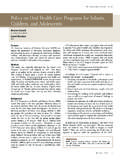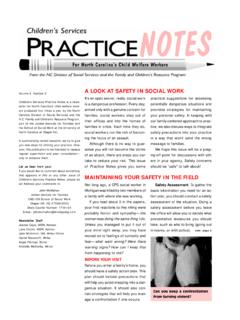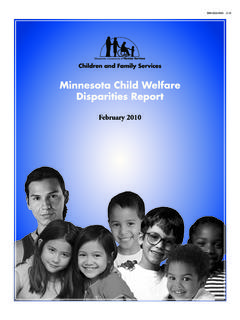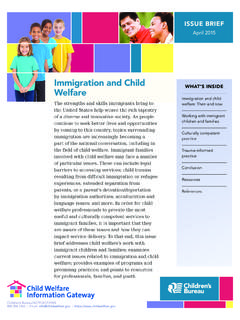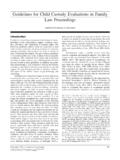Transcription of Guideline on Informed Consent - Pediatric Dentistry
1 AMERICAN ACADEMY OF Pediatric DENTISTRYCLINICAL PRACTICE GUIDELINES 315 PurposeThe American Academy of Pediatric Dentistry (AAPD) recog-nizes that Informed Consent is essential in the delivery of health care. The Informed Consent process allows the patient or, in the case of minors, the parent* to participate in and retain autonomy over the health care received. Informed con- sent also may decrease the practitioner s liability from claims associated with miscommunication. This Guideline recognizes that Informed Consent is governed by the statutes and case laws of individual states; oral health care providers should review the applicable laws and regulations of their state MethodsThis revision included a systematic literature search of the PubMed electronic database using the following parameters: Terms: Informed Consent , Pediatric Consent , Pediatric in- formed Consent , Consent , Informed refusal, cultural back- ground Informed Consent , linguistic background Informed Consent , and interpreters Informed Consent ; Fields: all; Limits: within the last 10 years, humans, English, review of legal cases.
2 One hundred fifty four articles matched these criteria. Papers for review were chosen from this list and from references within selected articles. When data did not appear sufficient or were inconclusive, recommendations were based upon expert and/ or consensus opinion by experienced researchers and legal practitioners. BackgroundInformed Consent is the process of providing the patient or, in the case of a minor or incompetent adult, the parent with relevant information regarding diagnosis and treatment needs so that an educated decision regarding treatment can be made by the patient or parent. The American Dental Association (ADA) states that dentists are required to provide informa- tion to patients/parents about the dental health problems the dentist observes, the nature of any proposed treatment, the po- tential benefits and risks associated with that treatment, any alternatives to the treatment proposed, and the potential risks and benefits of alternative treatments, including no treatment.
3 1 State laws and court decisions determine the criteria for Informed In 1914, a New York state court ruled that every human being of adult years and sound mind has a right to determine what shall be done with his own 3 Although most cases have involved other health professionals, oral health care providers should follow the rulings estab- lished by these cases. Ruling from the Supreme Court of North Dakota found that laws pertaining to a physician s duty to obtain Informed Consent also pertained to As court rulings and laws differ in each state, it is difficult to develop an inclusive Guideline . The law generally has several criteria for selecting informa- tion to provide to a patient/parent as part of an Informed Consent .
4 Some states follow a patient-oriented standard that information which a reasonably prudent patient/parent in same or similar circumstances would wish to ,6 Other states follow a practitioner-oriented standard that informa- tion which a health care provider, practicing within the standard of care, would reasonably provide to a patient/parent in the same ,7 A hybrid approach, combining the patient-oriented and practitioner-oriented standards, is followed by some ,7 Regardless of the standard a state has chosen to follow, the treating practitioner must disclose information that he/she considers material to the patient s/ parent s decision-making process and provide a warning of death or serious bodily injury where that is a known risk of the ,5,8 The Informed Consent process generally excludes adverse consequences associated with a simple pro- cedure if the risk of occurrence is considered remote and Originating CouncilCouncil on Clinical AffairsReview CouncilCouncil on Clinical AffairsAdopted 2005 Revised 2009, 2014, 2015 Guideline on Informed Consent * In all AAPD oral health care policies and clinical practice guidelines.
5 The term parent has a broad meaning encompassing a natural/biological father or mother of a child with full parental legal rights, a custodial parent who in the case of divorce has been awarded legal custody of a child, a person appointed by a court to be the legal guardian of a minor child, or a foster parent (a noncustodial parent caring for a child without parental support or protection who was placed by local welfare services or a court order). American Academy of Pediatric Dentistry . Reference Manual: Introduction. Pediatr Dent 2015;37(special issue) CLINICAL PRACTICE GUIDELINES REFERENCE MANUAL V 37 / NO 6 15 / 16when such circumstances commonly are understood by the profession to be generally is understood that the person granting Consent is the patient of the age of majority.
6 For patients under the age of majority or adults with diminished mental capacity, Informed Consent should be obtained from a ,5 The practitioner should be aware that the adult accompanying the Pediatric patient may not be a legal guardian allowed by law to Consent to medical procedures. Examples of such an adult include a grandparent, step-parent, noncustodial parent in instances of divorce, babysitter, or friend of the family. A child in foster care or a ward of the state may be accompanied by a caretaker who may or may not be allowed to Consent to medical procedures, according to individual state law. It is advisable that the oral health care provider obtain a copy of court orders appointing a guardian to verify who is authorized to Consent for medical treatment for the One option to consider is obtaining a parent s authorization via a Consent by proxy or power of attorney agreement for any other in- dividual to make dental treatment decisions for a ,9 In situations where individuals other than the parent regularly bring the child to the dental office, this can help eliminate doubt as to whether such individual has the legal authority to provide Informed Consent .
7 Practitioners, however, should consult their own attorney in deciding whether to utilize such a form in their own practice. Another option for obtaining authorization for treatment is a telephone conversation with the ,11 The parent should be told there are two people on the telephone and asked to verify the patient s name, date of birth, and address and to confirm he/she has responsibility for the ,11 The parent is presented with all elements of a valid Informed Consent followed by documentation in the patient s chart with ,11 Written Consent is required by some states before treatment of a ,5 Even if not mandated by state law, written con- sent is advisable as it may decrease the liability from miscom-munication. A patient s or parent s signing a Consent form should not preclude a thorough discussion.
8 Studies have shown that even when seemingly adequate information has been presented to patients/parents, their ability to fully un-derstand the information may be ,13 Dentists should be aware of the cultural and linguistic backgrounds of their patients and families and take care to ensure that information is available in culturally and linguistically competent formats to help parents in the decision-making Also, to assure a person who is deaf or hearing impaired can Consent , a dentist carefully should consider the patient s self-assessed communication needs before any treatment. Practitioners may need to provide access to translation services (eg, in person, by telephone, by subscription to a language line) and sign language Practitioners who receive federal funding, as well as those in a significant number of states, are mandated to provide these services at no cost to the Supplements such as informational booklets or videos may be helpful to the patient in understanding a proposed procedure.
9 The oral dis- cussion between provider and patient, not the completion of a form, is the important issue of Informed Consent . The Consent form should document the oral discussion of the proposed therapy, including risks, benefits, and possible alter- native therapy, as well as no ,11,15 Informed refusal occurs when the patient/parent refuses the proposed and alternative ,10,11 The dentist must inform the patient/parent about the consequences of not accepting the proposed treatment and obtain a signed Informed refusal. It is recommended by the ADA that Informed refusal be documented in the chart and that the practitioner should attempt to obtain an Informed refusal signed by the parent for retention in the patient record. An Informed refusal, however, does not release the dentist from the responsibility of providing a standard of If the dentist believes the Informed refusal violates proper standards of care, he/she should recommend the patient seek another opinion and/or dismiss the patient from the If the dentist suspects dental neglect, appropriate authorities should be a form is utilized, it is best to use simple words and phrases, avoiding technical terms, so that it may be easily understood.
10 A modified or customized Consent form is pre- ferred over a standard form and should be in a format that is readily understandable to a lay ,10,11,15,17 Overly broad statements such as any and all treatment deemed neces- or all treatment which the doctor in his/her best medical judgment deems necessary, including but not limited should be avoided. Courts have determined it to be so broad and unspecific that it does not satisfy the duty of in- formed Consent . Informed Consent discussion, when possible, should occur on a day separate from the treatment and the practitioner should avoid downplaying the risks involved with the proposed therapy. Items that should appear on a Consent form are listed under Recommendations.





